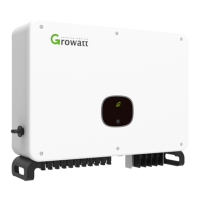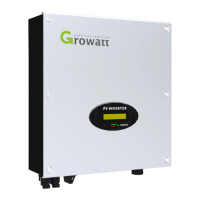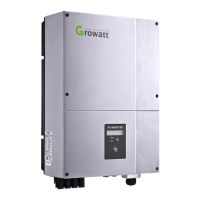What to do if Growatt MAC 30KTL3-X LV shows Warning 405?
- BBrian StevensSep 23, 2025
To address Warning 405 on your Growatt Inverter, check the firmware version. If the error message still exists, contact the manufacturer.
What to do if Growatt MAC 30KTL3-X LV shows Warning 405?
To address Warning 405 on your Growatt Inverter, check the firmware version. If the error message still exists, contact the manufacturer.
What to do if Growatt MAC 30KTL3-X LV Inverter displays Error 300?
If your Growatt Inverter displays Error 300, start by checking the grid voltage. If the grid voltage is within the acceptable range and the error persists, contact the manufacturer for further assistance.
What to do if Growatt MAC 30KTL3-X LV Inverter displays Error 303?
If your Growatt Inverter is showing Error 303, check the PE (Protective Earth) connection to ensure it is properly connected. If the error message continues to appear, contact the manufacturer.
What to do if Growatt Inverter shows Warning 402?
To resolve Warning 402 on your Growatt Inverter, first check if the optimizer is on. Next, verify the connection between the optimizer and the inverter to ensure it is normal.
What to do if Growatt MAC 30KTL3-X LV Inverter shows Warning 203?
If your Growatt Inverter shows Warning 203, check if the PV1 or PV2 wiring is short-circuited. If the error persists, contact the manufacturer.
How to fix Error 422 on Growatt MAC 30KTL3-X LV Inverter?
To resolve Error 422 on your Growatt Inverter, restart the inverter. If the error message persists, contact the manufacturer.
How to fix Error 415 on Growatt MAC 30KTL3-X LV?
To resolve Error 415 on your Growatt Inverter, restart the inverter. If the error message persists, contact the manufacturer.
How to fix Error 416 on Growatt MAC 30KTL3-X LV Inverter?
To resolve Error 416 on your Growatt Inverter, restart the inverter. If the error message persists, contact the manufacturer.
How to fix Error 304 on Growatt Inverter?
To resolve Error 304 on your Growatt Inverter, restart the inverter. If the error message persists, contact the manufacturer.
How to fix Warning 404 on Growatt MAC 30KTL3-X LV?
To resolve Warning 404 on your Growatt Inverter, restart the inverter. If the error message persists, contact the manufacturer.
Overview of Growatt MAC Series solar inverters and installation manual.
Specifies required qualifications for inverter installation personnel.
General safety guidelines and warnings for inverter installation and operation.
Explanation of warning and notice symbols used throughout the manual.
Description of labels found on the inverter and their meanings.
Details the physical appearance and key external components of the inverter.
Provides the physical dimensions and weight specifications for the inverter models.
Information presented on the inverter's nameplate, including model and technical data.
Explains the operational process of the inverter in an on-grid system.
Guidelines for safe and effective storage of the inverter before installation.
Information on grid connection methods for different MAC series inverter models.
Procedures for verifying the inverter and its accessories are complete and undamaged.
Fundamental requirements for the installation site and structure for the inverter.
Specifies ideal environmental conditions for optimal inverter performance and lifespan.
Safety instructions for handling and moving the heavy inverter unit.
Steps for installing the wall mount bracket to securely fix the inverter.
Guides on how to hang and secure the inverter onto the mounted bracket.
Procedures and safety precautions for connecting the inverter to the AC power grid.
Detailed instructions and safety warnings for connecting PV modules to the inverter.
Overview of methods and ports for establishing communication for monitoring.
Specific steps and wiring for setting up RS485 communication.
Use of the USB port for firmware updates or connecting monitoring accessories.
Procedures for ensuring proper grounding of the inverter for electrical safety.
Guidelines for implementing lightning protection and grounding for the system.
Steps to follow for checking and confirming the inverter's operational status.
Configuring the communication address for network connectivity and monitoring.
Instructions for setting the correct date and time on the inverter's internal clock.
Description of the different operational states of the inverter.
Inverter state when checking system parameters before grid connection.
Normal operational state where the inverter converts DC to AC and feeds the grid.
How the inverter indicates and handles fault conditions.
Conditions and process for the inverter to automatically shut down.
Illustrates the display interface shown when the inverter powers on.
How to reactivate the display after it has automatically turned off.
Navigating and configuring various inverter settings using touch controls.
Choosing appropriate voltage protection levels based on standards.
Changing the display language from the default Chinese.
Configuring the communication address for network integration.
Setting the internal clock for accurate logging and operation.
Overview of methods for accessing inverter data remotely.
Guide to using the ShinePhone app for remote inverter monitoring.
Accessing detailed inverter information, control, and parameters within the app.
Viewing system logs and fault information for troubleshooting.
Using the ShineGPRS-X web interface for remote monitoring of the system.
Accessing and interpreting plant and inverter performance data via the dashboard.
Detailed breakdown of inverter data, viewable by date or exportable.
General procedures for regular upkeep of the inverter.
Safe steps for cleaning the inverter to ensure optimal performance.
Procedures for cleaning or replacing the inverter's cooling fans.
Guidance on diagnosing and resolving common inverter issues and faults.
Explanation of warning codes indicating non-critical operational issues.
Explanation of error codes indicating critical faults requiring immediate attention.
| Model | MAC 30KTL3-X LV |
|---|---|
| Max. DC Voltage | 1100 V |
| Input Voltage Range | 200 V - 1000 V |
| MPPT Voltage Range | 200 V - 1000 V |
| Number of DC Inputs per MPPT | 2 |
| AC Voltage Range | 310 V - 480 V |
| Nominal Grid Frequency | 50 Hz / 60 Hz |
| Total Harmonic Distortion (THDi) | < 3 % |
| THD | <3% |
| DC Switch | Yes |
| Topology | Transformerless |
| Max. AC Output Current | 47.8A |
| Rated Power | 30 kW |
| Nominal AC Power | 30000 W |
| Nominal AC Voltage | 400 V |
| Power Factor Adjustment Range | 0.8 leading - 0.8 lagging |
| Power Factor | 0.99 |
| Protection Class | IP65 |
| Operating Temperature Range | -25 °C ... +60 °C |
| Protection Degree | IP65 |
| Max. AC Output Power | 33 kW |
| Max. DC Power | 45000W |
| Max. DC Input Power | 45000 W |












